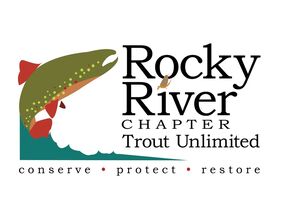Fly of the Month - 12.15 Chironimid
We continue with Part Four of Midges or diptera. Midge pupa fly patterns are likely not necessary on streams other than tailraces and spring creeks. Midges may be swarming over the water for various reasons yet the trout may be keyed on midge pupae. Generally an angler assumes that an adult midget (dry) fly pattern will work just fine. However, should such a fly pattern fail to connect for a take from rising fish, then the next fly pattern to put on is a midge emerger as stated in Part Three, then the next fly pattern to put on is a midge pupa. There is but a subtle difference to the angler yet a great difference to a selective trout.
Chironimid
The Chironimid is a floating sub-surface fly pattern that is designed to be fished with only the breathing tube part of the midge body just above or within the surface film. Once a trout becomes keyed on the suspended pupae and a specific body color they often become selective to only midge pupae for a period of time.
The Chironimid, TLC and Ice Cream Cone are three Midge pupa fly patterns that have become popular among spring creek and tailrace anglers. They are very similar in that all have the white breathing tube or smoke stack or post tied at the head of the fly pattern. White poly-yarn, White Z-Lon or a White CDC Puff all serve well for this element of the fly pattern. Keep in mind that CDC requires being dried with “frog’s fanny” or silicon powder rather than using a floatant fly dressing.
The Chironimid fly pattern in a variety of colors best imitates the Chironimidae which is a specific family of diptera. These insects are considered to be the true midges with each specific species of a different, unique and sometime very bright color. Their habitat is calm or slow moving water.
Fish the midge pupa in the same manner as a dry fly imitating any insect. Fish the glassy water, especially when there are rises to these almost invisible aquatic insects. Fish moving water as well but keep in mind that the more chop to the moving water the quicker a midge pupa (suspended) fly pattern will become drenched and sink. If you are having difficulty seeing the midge pupa (suspended) fly pattern, use an indicator or a larger dry fly at the upper end of the tippet. On tailraces and spring creeks a 5X tippet is too big, so plan to use 6X, 6.5X or 7X tippets with the midge pupa (suspended) fly.
Chironimid
Fly of the Month 12.15
……recipe and instructions…….
- Tom Adams, Alen Baker
We continue with Part Four of Midges or diptera. Midge pupa fly patterns are likely not necessary on streams other than tailraces and spring creeks. Midges may be swarming over the water for various reasons yet the trout may be keyed on midge pupae. Generally an angler assumes that an adult midget (dry) fly pattern will work just fine. However, should such a fly pattern fail to connect for a take from rising fish, then the next fly pattern to put on is a midge emerger as stated in Part Three, then the next fly pattern to put on is a midge pupa. There is but a subtle difference to the angler yet a great difference to a selective trout.
Chironimid
The Chironimid is a floating sub-surface fly pattern that is designed to be fished with only the breathing tube part of the midge body just above or within the surface film. Once a trout becomes keyed on the suspended pupae and a specific body color they often become selective to only midge pupae for a period of time.
The Chironimid, TLC and Ice Cream Cone are three Midge pupa fly patterns that have become popular among spring creek and tailrace anglers. They are very similar in that all have the white breathing tube or smoke stack or post tied at the head of the fly pattern. White poly-yarn, White Z-Lon or a White CDC Puff all serve well for this element of the fly pattern. Keep in mind that CDC requires being dried with “frog’s fanny” or silicon powder rather than using a floatant fly dressing.
The Chironimid fly pattern in a variety of colors best imitates the Chironimidae which is a specific family of diptera. These insects are considered to be the true midges with each specific species of a different, unique and sometime very bright color. Their habitat is calm or slow moving water.
Fish the midge pupa in the same manner as a dry fly imitating any insect. Fish the glassy water, especially when there are rises to these almost invisible aquatic insects. Fish moving water as well but keep in mind that the more chop to the moving water the quicker a midge pupa (suspended) fly pattern will become drenched and sink. If you are having difficulty seeing the midge pupa (suspended) fly pattern, use an indicator or a larger dry fly at the upper end of the tippet. On tailraces and spring creeks a 5X tippet is too big, so plan to use 6X, 6.5X or 7X tippets with the midge pupa (suspended) fly.
Chironimid
Fly of the Month 12.15
……recipe and instructions…….
- Tom Adams, Alen Baker
